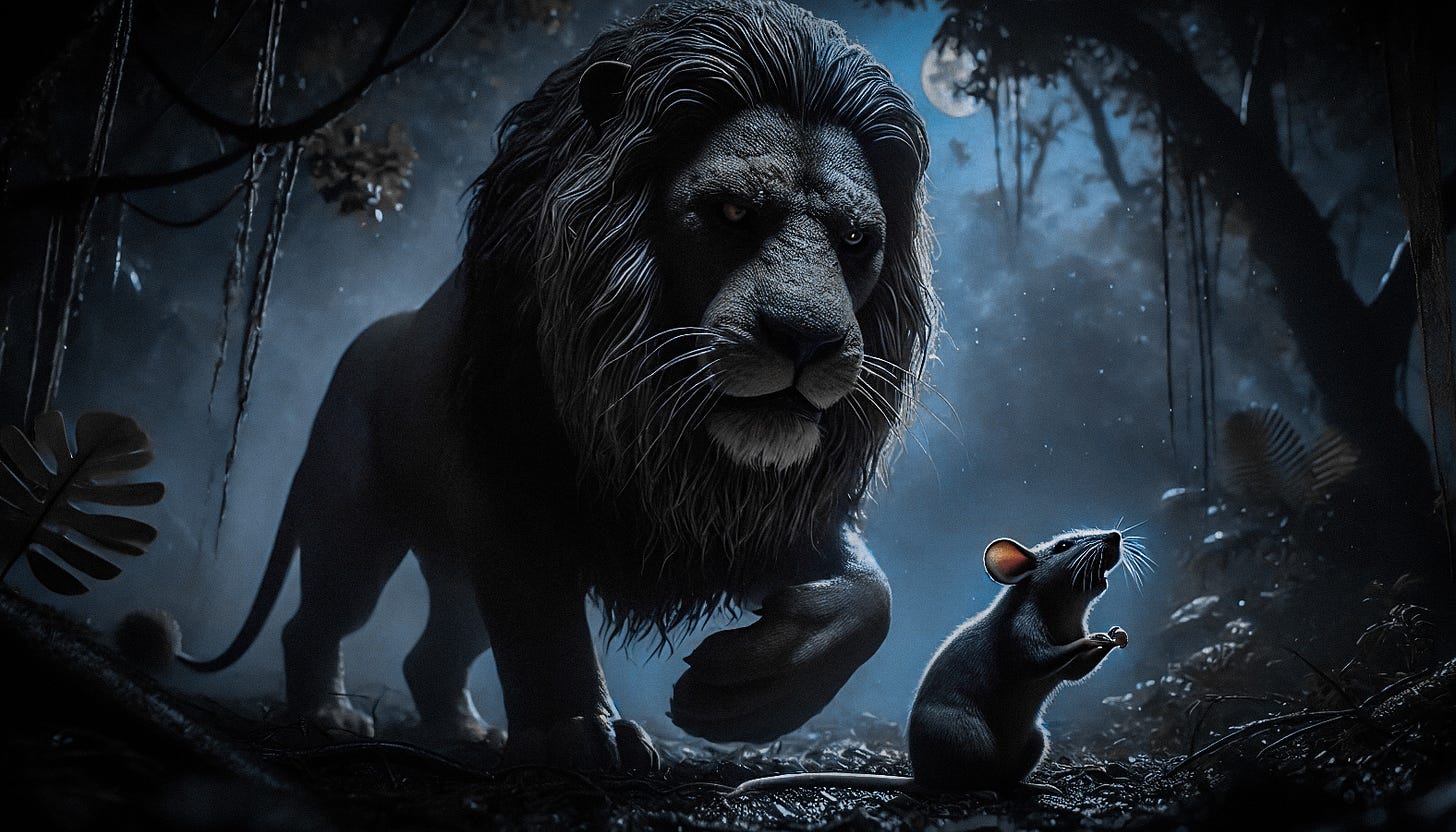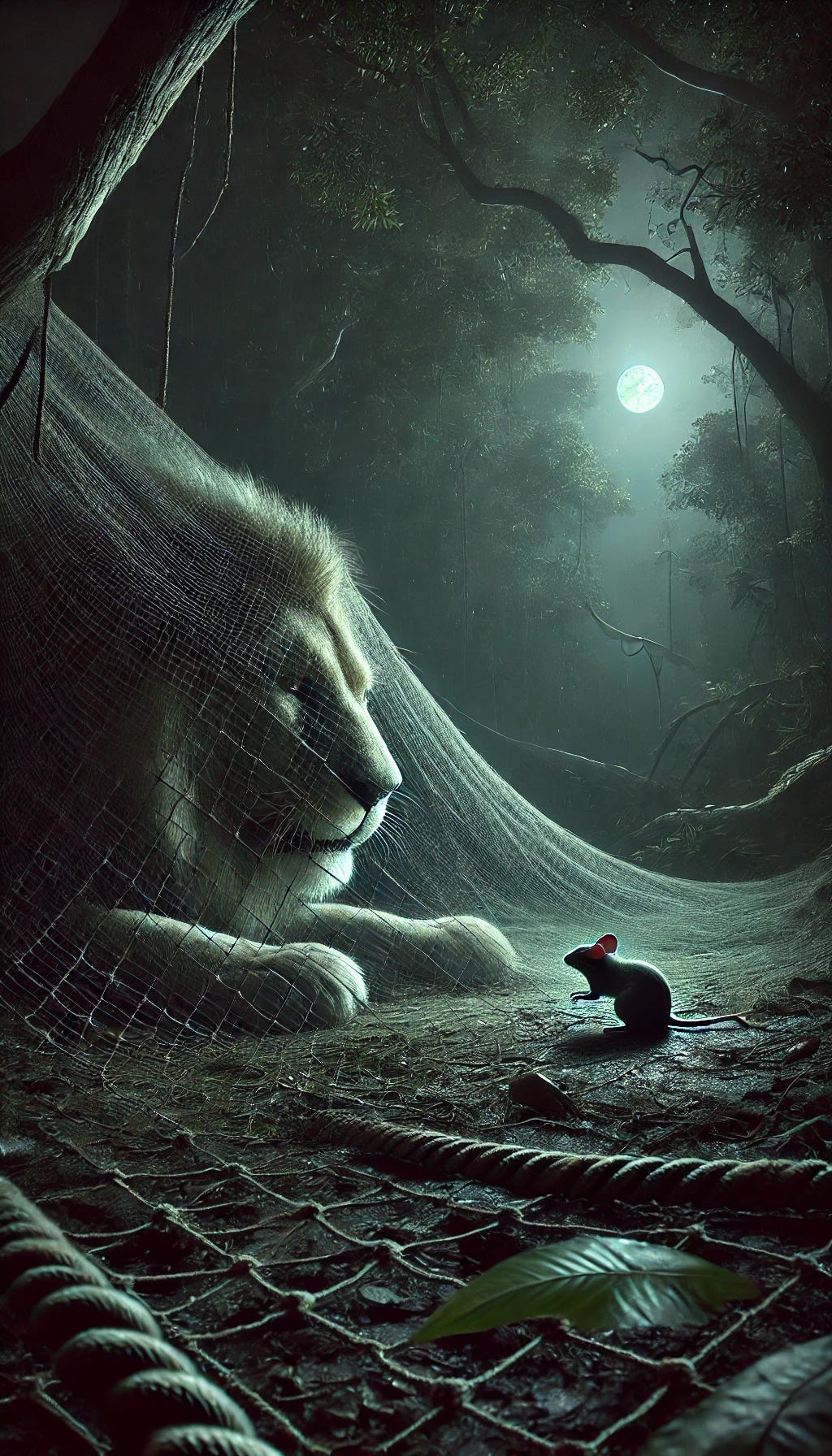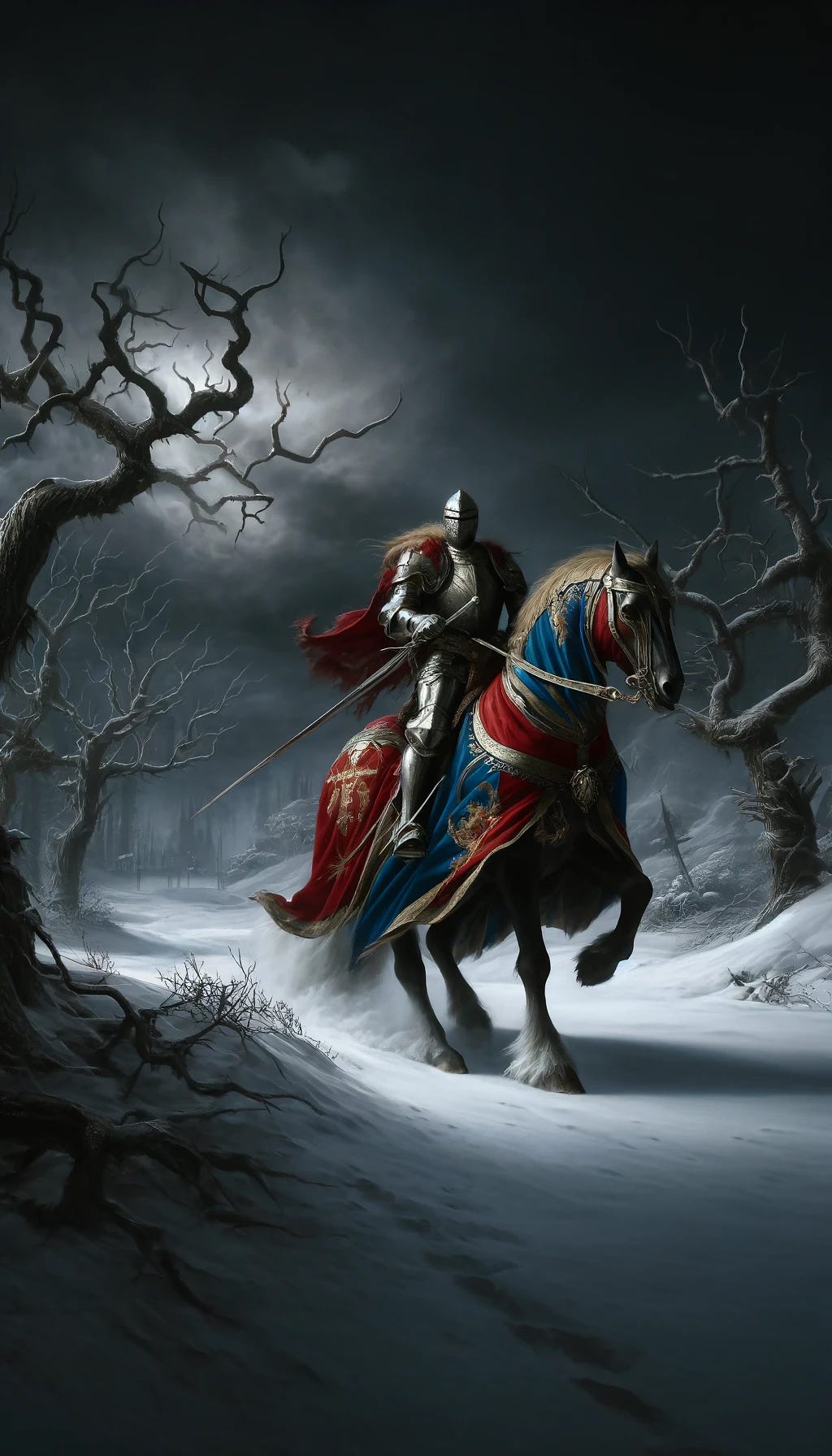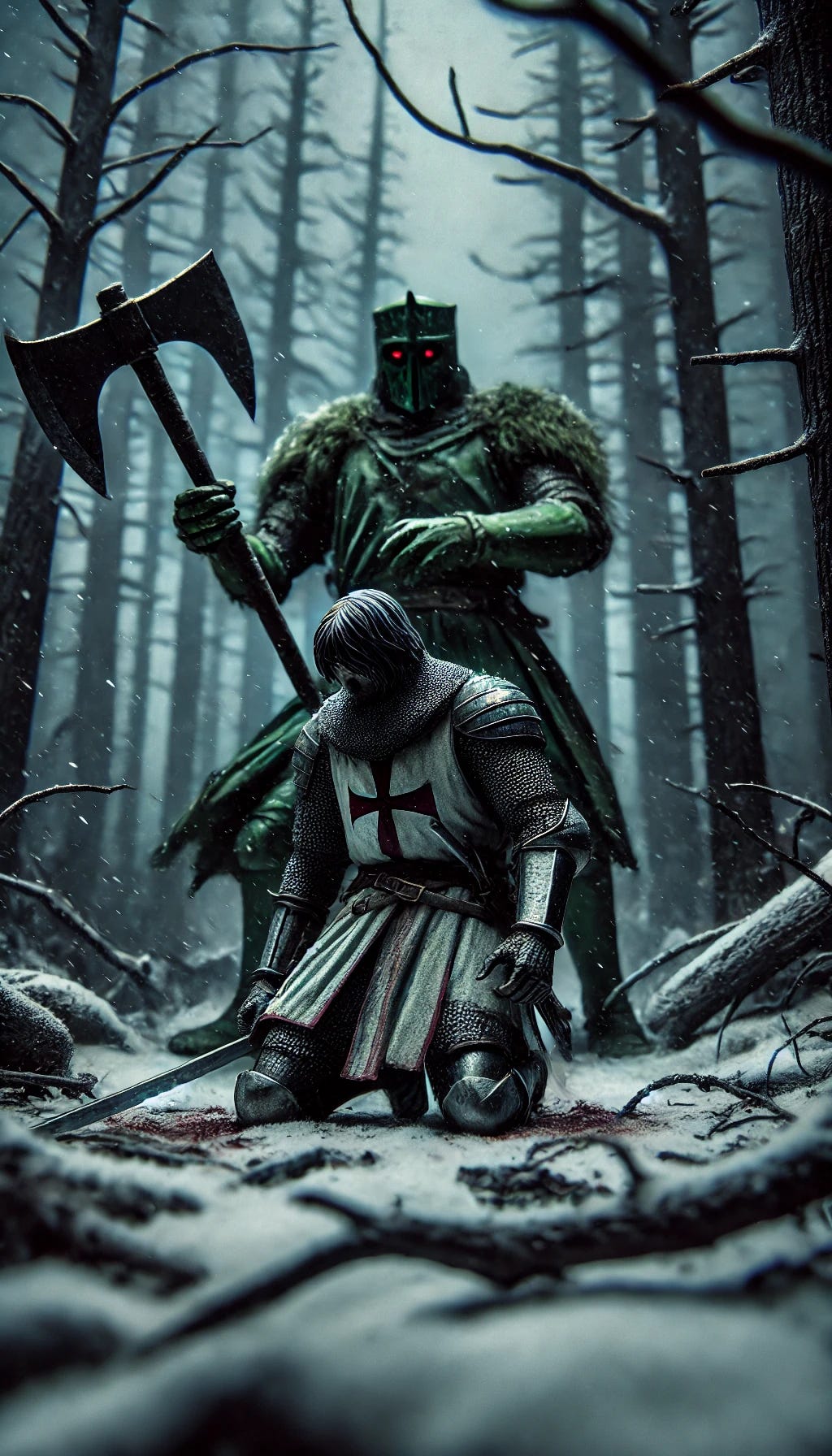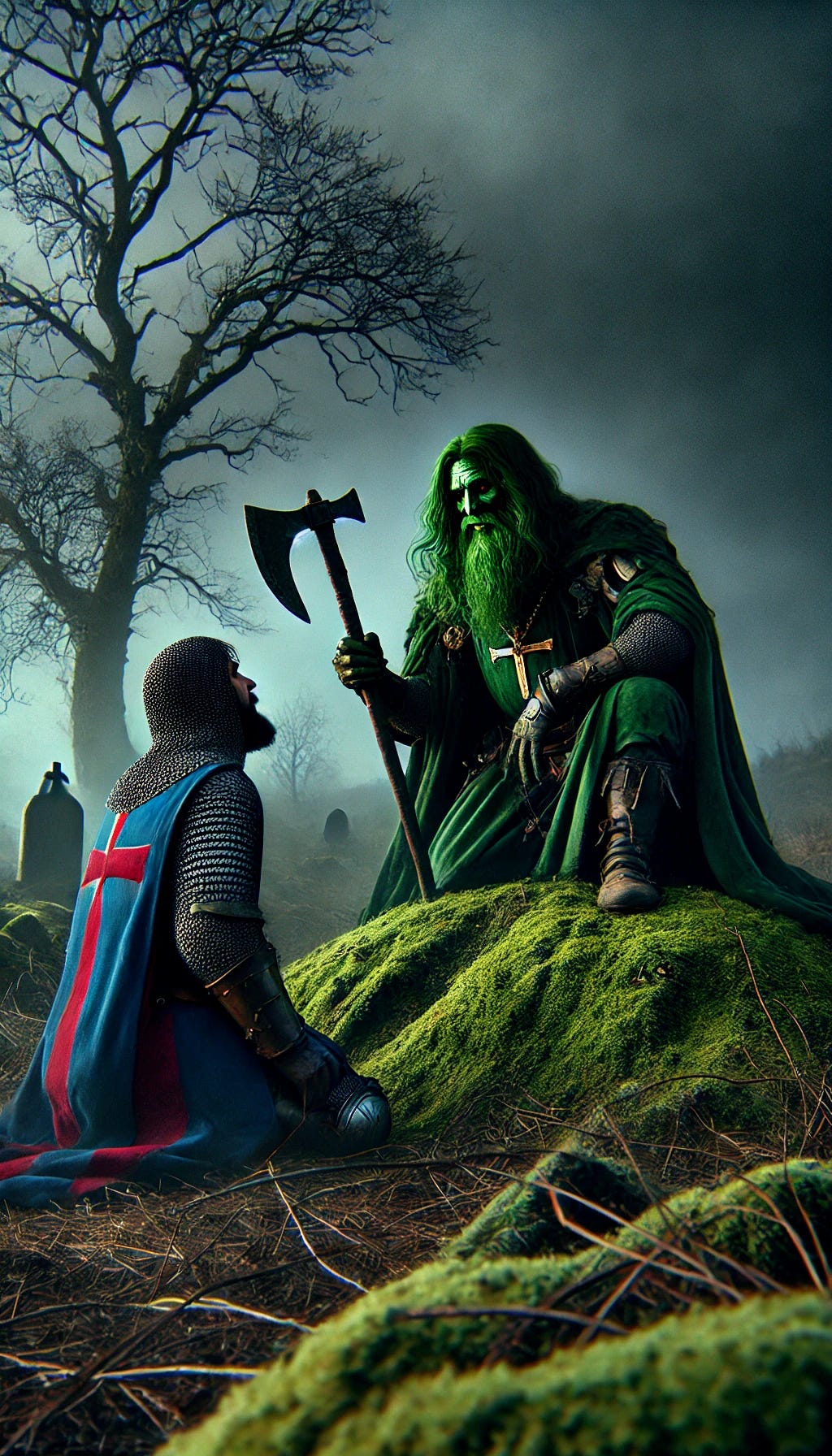Sir Gawain and the Infinite Game
The Importance of Reciprocity
Introduction
In this article, we will delve into Aesop's fable of the Lion and the Mouse, and the tale of Sir Gawain and the Green Knight to illustrate key aspects of social capital and its importance to organisational and contemporary leadership success. In his seminal book "The Better Angels of Our Nature," Steven Pinker posits that humanity has become progressively less violent and more cooperative over time. He attributes this transformation to factors such as effective governance and the spread of literacy, which have fostered social learning and cultural evolution.
These changes, Pinker asserts, have underscored the principle that broader cooperation yields more significant mutual benefit. Broadly, Pinker is pointing to mechanisms that build social capital. Defined by Robert Putnam as the networks, norms, and trust that facilitate coordination and cooperation for mutual benefit.
From an organisational perspective, social capital is a crucial cultural enabler —facilitating enhanced innovation, improved trust, and effective collaboration, all of which are essential for high performance. Social capital creates a cohesive environment that propels organisations forward, supporting better productivity, service delivery, risk mitigation, and employee retention. This article explores the importance of social capital in high-performing organisations and examines the leadership behaviours necessary to cultivate and sustain it. By examining Aesop's fable of the Lion and the Mouse, and the story of Sir Gawain and the Green Knight, we will uncover the enduring principles of reciprocity, accountability, and mutual support foundational to building robust social capital and achieving superior commercial outcomes.
Social Capital
Social capital is essential for understanding the cultural dynamics within organisations. Robert Putnam argues that social capital is the "fabric" that holds societies together, fostering civic engagement and cooperation. He documents the decline of social capital in America, linking this erosion to reduced civic participation and community cohesion.
Pierre Bourdieu defines social capital as the aggregate of resources linked to a durable network of relationships, providing members with collectively owned capital and access to opportunity. He highlights how social capital can perpetuate inequalities by offering unequal resource access. James Coleman further notes that social capital facilitates the actions of individuals within the structure. For Coleman, social capital is crucial for developing human capital, as it enables the sharing of information, norms, and values essential for success.
The four main components of social capital are networks, relationships, shared norms, and trust. Networks facilitate the flow of information and resources. Strong, trusting relationships foster cooperation and mutual support. Shared norms guide behaviour, creating predictability and trust. Trust reduces the need for extensive monitoring, enabling smoother collaboration.
Social Capital in Organisations
Social capital acts as a cultural lubricant, enabling the free flow of information and facilitating the willingness of employees to share knowledge and resources. High social capital leads to:
Greater Innovation: Innovation thrives in environments with high social capital. Strong networks and trusting relationships encourage the free exchange of ideas. Companies like Google and 3M promote open communication and collaboration, fostering innovation through high social capital.
Deeper Trust: Trust is a cornerstone of social capital. When employees trust each other, they fully engage with their work, cooperate with colleagues, and commit to organisational goals. Trust liberates, reducing micromanagement and enhancing productivity.
Employee Engagement: High social capital enhances employee engagement and reduces voluntary turnover. Engaged employees are more productive and provide better customer service. Companies like Zappos and Southwest Airlines, known for their strong cultures rooted in social capital, enjoy high employee engagement and low turnover rates.
Organisations with high social capital outperform those with lower levels. For instance, Google's open communication and collaboration culture drive productivity and innovation, making it one of the most successful tech companies. Similarly, based on trust and continuous improvement, Toyota's production system maintains high productivity and quality standards.
As organisational structures become more flexible and responsive, relying on strong social capital to drive performance is more critical than ever. However, challenges such as remote working, increased globalisation, and outdated leadership mindsets necessitate a renewed focus on building social capital through virtual communities, cross-cultural awareness, and effective leadership at all levels. Mature, enabling leadership and collaborative behaviour among colleagues are essential in navigating these challenges. We turn to ancient myths and fables to gain further insights, starting with Aesop's timeless tale of the Lion and the Mouse.
Aesop's Fable: The Lion and the Mouse
A Lion is sleeping when a Mouse runs over the mighty beast's face, awakening him. The Lion claps his paw upon the frightened little creature and is about to kill him when the Mouse, in a pitiable tone, begs the Lion to spare him, promising to repay the kindness. Smiling at his tiny prisoner's fright, the Lion lets him go.
Some days later, the Lion is caught by hunters and bound with strong ropes to the ground. Unable to escape, he lets out a mighty roar that echoes through the jungle. The Mouse, recognising the bellow, runs to the spot and, without more ado, sets to work nibbling through the cord that binds the Lion. Once the Lion is free, the Mouse says, "You laughed when I said I would repay you. Now you see that even a Mouse can help a Lion."
The story's moral is that no act of kindness, no matter how small, is ever wasted.
Reciprocity the Foundation of Social Capital
Though simple, the story of the Lion and the Mouse illuminates the foundational principles of social capital through moral acts of reciprocity. Reciprocity, as defined by the economist Gary Becker, is the mutual exchange of goods, services, or favours, often governed by a sense of obligation or social norms rather than explicit contracts. This mutual exchange is critical for building trust and cooperation within organisations.
Moral and altruistic behaviour fosters reciprocal relationships. Leaders who balance competing stakeholder requirements, serve others, and consistently do the right thing, like Lion's decision to spare Mouse, create a culture of mutual respect and cooperation within their teams. Consequently, moral reciprocity is the bedrock of social capital.
Trust is another cornerstone of effective leadership, built and reinforced through reciprocal actions. Leaders who engage in reciprocal acts, like Mouse gnawing through the rope, demonstrate reliability. Reliability, in turn, builds trust, which inspires commitment and dedication from colleagues and cultivates supportive relationships.
Leaders create bonds that promote collective well-being and social cohesion by engaging in reciprocity. Reciprocal behaviours enhance cooperation among community members, creating an environment essential for addressing collective challenges and achieving common goals. The relationship between Lion and Mouse exemplifies how, over time, even small reciprocal acts build social capital.
Effective leaders are moral and empathetic, building trust and long-term relationships through reciprocal actions. When leaders and colleagues consistently act with moral reciprocity, they cultivate a culture rich in social capital. This abundant social capital enhances cooperation, mutual aid, and overall organisational resilience, driving the enterprise's success.
The tale of the Lion and the Mouse illustrates how moral acts of reciprocity build social capital. The story of Sir Gawain and the Green Knight delves deeper into these principles, using themes of reciprocity and game theory to highlight the complexities of human interactions. By examining Sir Gawain's journey and challenges, we can better understand how reciprocal actions shape trust and cooperation. This exploration reveals the nuanced dynamics of reciprocal relationships and their impact on organisational success.
Sir Gawain and the Green Knight
The tale of Sir Gawain and the Green Knight, written in the late 14th century, blends elements of the natural world with the supernatural, symbolising the limits of human understanding [1]. The story focuses on morality, integrity, and the human condition.
The story begins during a New Year's Eve feast at King Arthur's court, where the knights and ladies of the Round Table celebrate. As the festivities peak, the great hall doors are thrown open, and a mysterious figure enters, halting the celebration. The entire assembly falls silent as they gaze upon the newcomer — a gigantic man, whose skin, hair, and garments are a vivid, unearthly green. The only contrasting colour is the bright red of his eyes, which gleam with an otherworldly light. This is the Green Knight, a terrifying and awe-inspiring figure [2].
The Green Knight rides an enormous green horse adorned in green trappings. He carries a holly branch in one hand, symbolising peace, and a massive axe in the other, symbolising war. The Green Knight rides directly up to King Arthur and issues a challenge. He proposes a game: any knight brave enough may strike him with his axe but must agree to receive a return blow in a year and a day [3]. The Green Knight makes it clear that this is a test of courage and honour. The knights are stunned into silence and fail to step forward. Seeing the hesitation of his knights, King Arthur himself is about to accept the challenge when Gawain, the king's young nephew, steps forward. Gawain kneels before the king and requests the honour of accepting the challenge on behalf of the court.
King Arthur consents and Gawain approaches the Green Knight, who dismounts and kneels, baring his neck. With one swing of the enormous axe, Gawain decapitates the Green Knight. To the astonishment of the court, the Green Knight's body does not fall. Instead, the headless figure stands, reaches down, picks up his severed head, and holds it aloft. The head, with eyes still open and mouth still speaking, reminds Gawain of their agreement. "Remember, Gawain, a year and a day from now, you must seek me out at the Green Chapel, where I will return the blow." With that, the Green Knight mounts his horse, holding his head by the hair, and rides out of the hall.
As the appointed time approaches for Sir Gawain to meet the Green Knight, he prepares for his journey with a heavy heart and a determined spirit. Winter has settled in, and the landscape is harsh and unforgiving. Gawain sets out alone, aware of the fate that lies ahead. His journey is fraught with peril. He battles fierce winter weather, treacherous terrain and wild beasts, testing his courage and resolve. Hunger, fatigue and fear of his fate gnaw at him. Despite these hardships, Gawain remains focused, driven by his commitment to the chivalric code.
One day, as Gawain travels through a dense forest, he comes upon a magnificent castle that appears out of nowhere [4]. The castle is grand and welcoming, starkly contrasting with the bleak and forbidding landscape. Gawain approaches the castle and is greeted warmly by its lord, a nobleman named Lord Bertilak, and his beautiful wife. Lord Bertilak, a man of imposing stature, extends his hospitality to Gawain, offering him shelter and rest. Gawain, grateful for the respite, accepts the offer and is treated to a sumptuous feast and a comfortable bed.
During his stay, Lord Bertilak proposes a game. He suggests that for the next three days, Bertilak will go hunting while Gawain remains at the castle. Each evening, they will exchange whatever they have gained during the day. Gawain agrees to the game, intrigued by the challenge and eager to honour his host's hospitality. On the first day, as Lord Bertilak goes hunting, Lady Bertilak visits Gawain in his chambers and attempts to seduce him. However, Gawain, committed to his knightly virtues, resists her advances. Instead, Lady Bertilak gives him a single kiss which Gawain dutifully gives to Lord Bertilak when he returns from his hunt with a deer.
The second day follows a similar pattern. Lord Bertilak goes hunting and Lady Bertilak visits Gawain, attempting again to seduce him. Gawain, steadfast in his resolve, resists her, and she gives him two kisses. That evening, Gawain kisses Lord Bertilak who, in return, offers Gawain the boar he has hunted. On the third day, Lady Bertilak's advances are more intense. She gives Gawain three kisses and offers him a green girdle that she claims has magical properties and will protect him from harm. Gawain, fearing for his life as he contemplates his encounter with the Green Knight, decides to keep the girdle and does not mention it to Lord Bertilak, breaking the agreement of their game. However, he gives Lord Bertilak the three kisses he received that day.
With the three days of the game completed, Gawain prepares to leave the castle and continue his journey to the Green Chapel. He is torn between his fear and sense of honour but remains resolute in his decision to face the Green Knight. Gawain sets out once more, determined to meet his fate with courage. Finally, after days of treacherous travel, Gawain arrives at a desolate, eerie clearing where the Green Chapel stands. The chapel is not a grand structure but a mound with a cave covered with grass and moss, blending into the wild landscape. As Gawain approaches, he hears the unmistakable sound of metal on stone. The Green Knight is there, sharpening a massive axe. The sight of the Green Knight, calm and methodical in his preparations, sends a chill through Gawain, but he gathers his courage and steps forward.
The Green Knight greets Gawain with a knowing smile, acknowledging his arrival and commending him for keeping his word. Gawain, faithful to his knightly vows, kneels and bares his neck, ready to receive the return blow as promised. The Green Knight raises the axe and feints the first blow, stopping short of Gawain's neck. Gawain flinches but remains steadfast. The second swing is another feint, and Gawain, though trembling, does not move. The third time, the Green Knight swings the axe and nicks Gawain's neck, drawing a small amount of blood but not causing serious harm. Gawain stands, relieved to be alive but puzzled by the Green Knight's actions.
It is then that the Green Knight reveals his true identity. He is none other than Lord Bertilak, transformed by the magic of Morgan le Fay, King Arthur's half-sister. Morgan le Fay, a powerful sorceress, orchestrated this entire challenge to test the honour and integrity of the knights of the Round Table. Lord Bertilak explains the significance of each blow. The first two feints recognised Gawain's honesty on the first two days of the game when he faithfully gave Bertilak the kisses he received from Lady Bertilak. The third blow drew blood for Gawain's dishonesty on the third day when he kept the green girdle for himself instead of giving it to Bertilak as agreed.
Gawain is filled with a mix of relief, shame, and gratitude. He realises that his life was spared, but he also acknowledges his failure to be completely truthful. Bertilak, however, praises Gawain for his courage and integrity, acknowledging that even the greatest of people are not without flaws. With the test complete, Gawain returns to Camelot, wearing the green girdle to symbolise his imperfection. In solidarity and respect, the knights of the Round Table adopt a green sash, honouring Gawain's acknowledgment of his shortcomings.
Moral Reciprocity: The Infinite Game
Gawain's quest serves as a symbolic rite of passage. Through his trials, he gains self-awareness and maturity, emerging with a deep understanding of his nature and the virtues he upholds. The tale underscores themes of honour, bravery, and the complexities of human morality. It highlights the importance of integrity, humility, keeping one's word, and the significance of reciprocal relationships, trust, and social capital.
True Courage and Accountability
One of the most significant lessons for contemporary leadership from the tale revolves around the nature of courage, a concept often entangled with machismo. The story challenges this traditional notion by illustrating that true courage transcends physical bravery. Through Gawain's trials, it is evident that genuine courage lies in the capacity for accountability, the readiness to face the repercussions of one's actions, and the ability to confront personal weaknesses while striving for virtue despite them [5] [6].
Accountability and Reciprocity
The tale reinforces the importance of accountability in reciprocity. Gawain steps forward when the Green Knight issues his challenge, demonstrating his commitment to a reciprocal agreement. He understands he must honour his promise to receive a return blow in the future. This test of Gawain's integrity underscores the mutual expectations of reciprocal accountability. Despite the personal cost, his unwavering dedication to fulfilling his promise illustrates its essence.
In an organisational context, leaders who honour their agreements and hold themselves accountable inspire trust and respect within their teams. This behaviour fosters a culture of mutual accountability, where team members are more likely to meet their obligations and support one another. Ultimately, reciprocal accountability builds a foundation of trust and reliability, driving social capital and fostering cohesive and high-performing organisations.
The Infinite Nature of Reciprocity
Thus far, the tales have highlighted reciprocity as a single exchange, but in reality, reciprocity is an infinite game of multiple unpredictable exchanges over time. The Green Knight story symbolically represents this through the three-day game between Gawain and Bertilak.
During these three days, there was cooperative exchange on the first two days and deception by Gawain on the third day, as he kept the green girdle, hoping it would save him from his fate [7]. This episode underscores the complexity of reciprocal relationships and the ongoing nature of building trust and integrity. To better untangle this complexity, we can turn to game theory.
Game theory is a mathematical framework used to analyse situations where multiple decision-makers, or "players," interact and make choices that collectively determine the outcome. It provides a systematic approach to understanding strategic behaviour in competitive and cooperative settings. The core elements of game theory include players, strategies, payoffs, and equilibrium. Players are the decision-makers, strategies are the options available to them, payoffs are the rewards or outcomes resulting from the chosen strategies, and equilibrium refers to a stable state where no player can benefit by unilaterally changing their strategy.
A classic example within game theory is the Prisoner's Dilemma, which illustrates the challenges of cooperation versus non-cooperation. In the Prisoner's Dilemma, two individuals must choose whether to cooperate or betray each other without knowing what the other will do. If both cooperate, they receive moderate rewards. If one betrays while the other cooperates, the betrayer gets a significant reward, while the cooperator gets a severe penalty. If both betray, they both receive moderate penalties. The dilemma shows that while cooperation yields the best collective outcome, fear of betrayal can lead to mutual harm.
Applying this to Bertilak's game and the Green Knight's final test, we see a symbolic representation of this dilemma. Gawain cooperates fully on the first two days, earning two feints of the axe from the Green Knight, signifying cooperation. On the third day, his deception results in a small nick from the Green Knight. This nick symbolises the cost of partial non-cooperation — a lesser penalty than complete betrayal but a penalty, nonetheless.
This "tit for tat" strategy is effective at dealing with the unpredictability of another's behaviour in reciprocal situations. In this strategy, a player mirrors the opponent's previous action — aggression is met with aggression and cooperation with cooperation. The strategy shapes behaviour, fostering collaboration and deterring betrayal. The Green Knight's actions showcase "tit for tat," where his first two feints reward Gawain's honesty, and the third blow penalises his deception [8].
The tale of Sir Gawain and the Green Knight teaches us that enduring relationships and a culture of mutual respect and accountability are built through continuous reciprocal actions, guided by principles of game theory to address both cooperation and its breaches. Leaders need to understand the complex dynamics of reciprocity as an infinite mutual exchange rooted in positive (reward-based) and negative (punishment-based) actions to shape and build social capital in their organisations optimally.
The Importance of Redemption
Sir Gawain's journey delves into the complexity of the human condition, emphasising the core values of humility, honesty, and personal integrity. His trials reveal the difficulties of maintaining one's morality in the face of temptation and fear, shedding light on the universal human experience and the significance of redemption [9].
Earlier articles have highlighted the importance of redemption, and Sir Gawain's story offers further insight [10]. The Green Chapel and the final encounter with the Green Knight symbolise judgment, where Gawain confronts his actions and finds moral redemption. The Green Knight chastises Gawain for his breach of integrity by hiding the green girdle. The tale underscores the necessity of facing one's mistakes with honesty and humility.
When Gawain returns to Camelot wearing the green girdle, he admits his failure and commits to atonement. This public repentance acknowledges his mistake and his resolve to improve, highlighting that redemption is possible if one confronts one's errors truthfully and strives to improve.
Gawain's process is challenging. He must face the court and admit his lapse in honesty, breaking the knight's moral code. Yet, through contrition, he sets himself back on the path of righteousness and honour. Only through confessing his mistake does Gawain begin to restore his honour. The knights' decision to wear green sashes in solidarity highlights that true strength lies in admitting faults and striving to rectify them.
Gawain's tale reminds us that redemption is always within reach for those willing to face their shortcomings honestly, learn from them, and commit to personal betterment. The lesson for contemporary leadership is clear: by admitting mistakes, confronting wrongdoing, and striving to improve, one can return to the right path. Contrition is challenging, but ignoring one's conscience is the path to ruin.
Summary
This article argues for the pivotal role of social capital in driving commercial success. Exploring the principles of social capital and leadership reveals critical insights essential for contemporary leadership. Social capital, which encompasses networks, norms, and trust facilitating coordination and cooperation, is a crucial driver of innovation, trust, and collaboration. It fosters a cohesive environment that boosts productivity, service delivery, risk mitigation, and employee retention. Companies like Google and Toyota exemplify how high social capital leads to more significant innovation, deeper trust, and higher employee engagement.
Reciprocity at all levels is instrumental in building social capital. Moral reciprocity — mutual exchange governed by social norms rather than explicit contracts — fosters trust and cooperation. Leaders who consistently practise moral reciprocity cultivate a culture rich in social capital, enhancing organisational resilience and success.
The stories of the Lion and the Mouse, and Sir Gawain highlight the complexities of reciprocal relationships and the significance of reciprocal accountability and integrity. Despite personal costs, Gawain's unwavering commitment to fulfilling his promise exemplifies the importance of accountability in reciprocity. Through Gawain's trials, it is evident that genuine courage lies in the capacity for accountability, the readiness to face the repercussions of one's actions, and the ability to confront personal weaknesses while striving for virtue despite them.
Game theory, particularly the "Prisoner's Dilemma" and "tit for tat" strategies, provides a framework for understanding reciprocal relationship dynamics. Gawain's journey symbolises the infinite game of reciprocity through his exchanges with Bertilak. This tale teaches us that enduring relationships and a culture of mutual respect are built through continuous reciprocal actions guided by game theory principles to address cooperation and breaches.
Gawain's journey underscores the importance of humility, honesty, and personal integrity. His redemption through public repentance highlights that personal progress lies in admitting faults and striving to rectify them. For contemporary leaders, the lesson is clear: admitting mistakes, confronting wrongdoing, and seeking to improve builds social capital, fosters trust and ensures long-term success.
Embrace the infinite game of reciprocal accountability in your leadership journey. Commit to continuous, mutual exchanges of trust and support, fostering a culture where integrity, humility, and collaboration thrive. Playing this infinite game will build stronger relationships, enhance social capital, and drive sustainable success for your organisation. Start today by holding yourself accountable, honouring your commitments, and encouraging your team to do the same.
References
Aesop’s Illustrated Fables, Barnes & Noble, 2013
Bowling Alone: The Collapse and Revival of American Community, Putnam, 2000
Foundations of Social Theory, Coleman, 1990
Informal Networks: The Company Behind the Chart, Harvard Business Review, Krackhart & Hanson, 1993
Knowledge Transfer in Intra-Organizational Networks: Effects of Network Position and Absorptive Capacity on Business Unit Innovation and Performance, Academy of Management Journal, Tsai, 2001
Learn Game Theory: A Primer to Strategic Thinking and Advanced Decision-Making, 2021, Rutherford
Reciprocity, Becker, 1986
Sir Gawain and the Green Knight, Armitage, 2018
Social capital: How networks, relationships, and trust among individuals, teams, and business leaders hold organizations together, McKinsey & Company, 2022
Social Capital, Networks, and Knowledge Transfer, Academy of Management Review, Inkpen & Tsang, 2005
Social Networks and the Performance of Individuals and Groups, Academy of Management Journal, Sparrowe, 2001
The Art of Strategy – A Game Theorist′s Guide to Success in Business and Life, 2008, Dixit & Nalebuff
The Better Angels of Our Nature: Why Violence Has Declined, Pinker, 2011
The Forms of Capital. In: Richardson, J. (Ed.), Handbook of Theory and Research for the Sociology of Education, Bourdieu, 1986
The Social Networks of High and Low Self-Monitors: Implications for Workplace Performance, Administrative Science Quarterly, Brass, Kilduff & Mehra, 2001
The Social Side of Creativity: A Static and Dynamic Social Network Perspective, Academy of Management Review, Perry-Smith & Shalley, 2003
Footnote
[1] The film 'The Green Knight' sticks reasonably closely to the original story. Its ending is darker. Sir Gawain succumbs further to Lady Bertilak's pursuit, and we are left uncertain of Gawain's final fate.
[2] The Green Knight represents nature, the supernatural, and challenges to human ideals. His challenge disrupts the orderly world of Camelot, forcing Gawain to confront the limits of human control and understanding. Green is associated with growth, renewal, and the cyclical patterns of nature. The Green Knight's colour symbolises themes of regeneration and the idea that life is a continuous cycle of challenges and renewals.
[3] The phrase "a year and a day" symbolises a complete cycle, representing the natural passage of time and marking a period for significant changes, emphasising a sense of ritualistic completeness beyond the ordinary year. It also signifies a time of testing and transformation, allowing for growth, reflection, and change, ensuring that Gawain is prepared for the challenge ahead — his journey of self-discovery and maturation.
[4] The castle symbolises temptation and the trials of virtue. Gawain faces seduction by Bertilak's wife and the moral test of the exchange game. These temptations challenge Gawain's commitment to his knightly virtues.
[5] The tale challenges the unrealistic expectations of chivalry. The story critiques the unrealistic expectations placed on humankind by presenting Gawain as flawed despite his best efforts and his ultimate failure to live up to the chivalric code. It suggests that being accountable and seeking to improve one's imperfections is crucial to true honour.
[6] The tale is an allegory for human experience. Gawain's quest represents the universal human journey. His trials and growth reflect the broader struggles of maintaining virtue and integrity in facing life's challenges.
[7] The green girdle symbolises moral flaw.
[8] The Green Knight carries holly in one hand and an axe in the other. These symbolise peace and war, reinforcing the Green Knight's potential for chaos and order. As such, they foreshadow the infinite game with Bertilak by representing the response options available in "tit for tat" — cooperation and aggression.
[9] The story explores the contrast between ideals and human imperfection — symbolising the tension between ideals and reality, the need to strive to better ourselves, and the inevitability of our lapses along the way.
[10] See "Beyond Bargain: Deal with the Devil".


